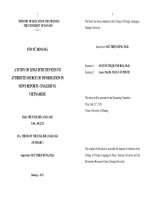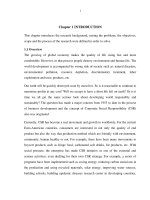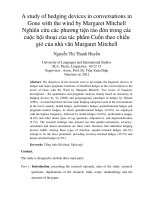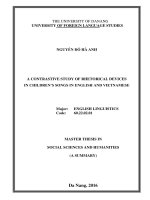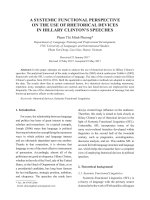A study of rhetorical devices in articles from national geographic magazine
Bạn đang xem bản rút gọn của tài liệu. Xem và tải ngay bản đầy đủ của tài liệu tại đây (1.28 MB, 87 trang )
MINISTRY OF EDUCATION AND TRAINING
QUY NHON UNIVERSITY
NGUYỄN THỊ XUÂN DUNG
A STUDY OF RHETORICAL DEVICES IN
ARTICLES FROM NATIONAL GEOGRAPHIC
MAGAZINE
Field: English Linguistics
Code: 8220201
Supervisor: HA THANH HAI, PhD
BỘ GIÁO DỤC VÀ ĐÀO TẠO
TRƯỜNG ĐẠI HỌC QUY NHƠN
NGUYỄN THỊ XUÂN DUNG
BIỆN PHÁP TU TỪ TRONG CÁC BÀI BÁO
THUỘC TẠP CHÍ NATIONAL GEOGRAPHIC
Ngành: Ngôn ngữ Anh
Mã số: 8220201
Người hướng dẫn: TS. Hà Thanh Hải
i
STATEMENT OF AUTHORSHIP
This thesis does not contain any information that has been published
elsewhere with the exception of references stated within the thesis. No other
person's work has been used in the thesis without giving proper credit. This
thesis has not been submitted to any other tertiary institution for consideration
for a degree or diploma.
Binh Dinh, 2023
Nguyễn Thị Xuân Dung
ii
ACKNOWLEDGEMENTS
First and foremost, I would want to sincerely thank and appreciate my
supervisor, Dr. Ha Thanh Hai, for all of his assistance and support in helping
me finish this thesis. He took the time to read my manuscripts and make the
necessary edits, for which I am also grateful.
I want to express my gratitude to the course lecturers for their insightful
discussions, helpful resources, and insightful experiences that helped lay the
groundwork for my thesis.
I am so appreciative of my friends for supporting me and getting me the
supplies I needed.
My sincere gratitude is extended to my family, who have always
looked after me and have helped me go through a lot of stress while I've been
studying for this thesis and the course.
iii
ABSTRACT
The primary goal of this thesis is to highlight common rhetorical device
elements, their frequency of occurrence in NatGeo articles, and their role in
ensuring the appeal and persuasiveness of these articles. The six categories of
rhetorical devices examined in this study are personification, simile,
personification, repetition, rhetorical question, and hyperbole. They are all
included in the lexical rhetorical group. This study employs Galperin's
theoretical framework (Galperin, 1977) to examine rhetorical devices in the
articles. Between 2021 and the first half of 2023, 50 NatGeo articles serve as
the study's data. To provide more accurate information on rhetorical devices
used in magazine language, they are lexically characterized and studied using
both qualitative and quantitative methods. The results indicate that six
rhetorical devices appear in varying proportions. It seems that grabbing
readers' attention is the primary objective of rhetorical devices in articles.
However, every style has a specific function. Repetition has the lowest
amount, whereas metaphor makes up a far bigger percentage than any other.
This study only makes up a small portion of the body of research on rhetorical
devices. Its findings may be used to teach and learn English rhetorical devices
generally, and rhetorical devices in articles specifically, as rhetorical devices
are useful in literature, linguistics, and education.
iv
TABLE OF CONTENTS
STATEMENT OF AUTHORSHIP
ACKNOWLEDGEMENTS
ABSTRACT
TABLE OF CONTENTS
CONVENTIONS
LIST OF TABLES
LIST OF FIGURES
CHAPTER 1. INTRODUCTION ................................................................ 1
1.1. Rationale ................................................................................................. 1
1.2. Aims and objectives ................................................................................ 3
1.2.1. Aims ............................................................................................... 3
1.2.2. Objectives....................................................................................... 3
1.4. Scope of the study ................................................................................... 3
1.5. Methods of the study ............................................................................... 4
1.6. Significance of the study ......................................................................... 4
1.7. Organization of the study ........................................................................ 4
1.8. Summary ................................................................................................. 5
CHAPTER 2. LITERATURE REVIEW .................................................... 6
2.1. Review of prior studies on rhetorical devices .......................................... 6
2.2. Rhetorical Devices .................................................................................. 7
2.2.1 Definitions of Rhetorical Devices .................................................... 7
2.2.2 Functions of Rhetorical Devices ...................................................... 9
2.3. Classification of rhetorical devices ........................................................ 10
2.3.1 Phonetic rhetorical devices ............................................................ 11
2.3.2 Syntactical rhetorical devices ........................................................ 12
v
2.3.3 Lexical rhetorical devices .............................................................. 12
2.3.4 National Geographic (NatGeo) ...................................................... 30
2.4. Summary ............................................................................................... 31
CHAPTER 3. METHODOLOGY ............................................................. 33
3.1. Research Design .................................................................................... 33
3.2. Research Methods ................................................................................. 33
3.3. Data Analysis ........................................................................................ 34
3.4. Research Procedure ............................................................................... 34
3.5. Reliability and Validity ......................................................................... 35
3.6. Summary ............................................................................................... 35
CHAPTER 4. FINDINGS AND DISCUSSION ........................................ 36
4.1. Frequency of occurrence of commonly-used rhetorical devices in NatGeo
articles.......................................................................................................... 36
4.2. Metaphor ............................................................................................... 37
4.3. Simile .................................................................................................... 41
4.4. Hyperbole.............................................................................................. 46
4.5. Personification....................................................................................... 52
4.6. Rhetorical question................................................................................ 55
4.7. Repetition .............................................................................................. 57
CHAPTER 5. CONCLUSION AND IMPLICATIONS ........................... 61
5.1. Conclusion ............................................................................................ 61
5.2. Implications........................................................................................... 63
5.3. Limitations of the study ......................................................................... 64
5.4. Suggestions for further research ............................................................ 64
REFERENCES........................................................................................... 66
APPENDIX................................................................................................. 69
vi
CONVENTIONS
- [NatGeo1-50]: NatGeo articles are numbered from 1 to 50. (details in
Appendix)
- [Met]: metaphor
- [Sim]: simile
- [Hyp]: hyperbole
- [Per]: personification
- [Rhe]: rhetorical questions
- [Rep]: repetition
- Italic words are used for emphasis, examples or the use of technical terms.
- Underlined words mark the use of what is being demonstrated.
vii
LIST OF TABLES
Table 4.1. Frequency of Occurrence of Rhetorical Devices in NatGeo articles.......36
viii
LIST OF FIGURES
Figure 4.1. Distribution of Rhetorical Devices...........................................................37
1
CHAPTER 1. INTRODUCTION
The current chapter discusses the main ideas of the thesis and offers the
study's justification. The primary justifications for carrying out the study are
stated at the start. The research questions are then used to state and further
define the thesis's objectives. The chapter also goes into the significance and
range of the current investigation. An explanation of how the thesis is
structured comes near the end.
1.1. Rationale
By serving as the foundation for the majority of our social and political
knowledge, magazines today are an essential component of human existence.
Bell (1991) identified three main kinds in newspaper text: news, commentary,
and service information. Lists like sports scores, TV shows, share prices, and
weather forecasts are included in the service information category. The most
common text kind in newspaper discourse is news, which provides
information about the most recent news occurrences. The text of an opinion
expresses the publication's personal viewpoints on a subject. Newspapers are
regarded as a reliable source of information for readers to stay up to date on
current events. Newspapers are regarded as a trustworthy source of
information that keeps readers up to date on current events. They are well-
known as a non-electronic form of media everywhere.
They are currently available in this period online, on their individual
news portals. Newspapers are not only an inexpensive source of current
information, but also a wealth of linguistic knowledge (Shahnaz & Imtiaz,
2014). Different ideas and grammatical styles make up newspaper articles. In
order to convey the content to readers, writers use a variety of technologies
and communication techniques (Rahmat, 2019). Newspaper opinion has been
approached from a variety of perspectives in media studies (Elyazale, 2014).
The content presented in different magazines represents the information
2
and ideas of specific interests. Each magazine therefore has its own goals and
readership. One of the most well-known publications in the world is National
Geographic, whose mission is "to illuminate and protect." Because the articles
stand alone as narratives, National Geographic's method of conveying
information differs from that of other periodicals. The dissemination of
geographic information broadly construed to cover the locations, people, and
cultures of the world was the initial aim of National Geographic, according to
Magazine Publishers of America (2006). In order to accomplish its goal,
National Geographic (NatGeo) employs a number of rhetorical strategies to
make its stories succinct, factual, and vivid as well as to provide readers a rich
imagination and a wealth of associations to arouse their interest in reading.
An essential feature of the magazine is its frequent and extensive use of
rhetorical devices, which is a useful technique for making stories appealing.
By "creating vivid pictures" for the readers to visualize and arouse their
pleasant feelings while reading, rhetorical methods are used in the magazine
to attract and catch their attention. Rhetorical devices prove their
effectiveness in expressing the author's ideas and intention in terms of
language and linguistic functions. The use of rhetorical techniques is common
in a variety of contexts, including the arts, literature, communication, public
speaking, and everyday life. Numerous linguists and researchers have studied
rhetorical or stylistic devices, but in a diverse range of ways.
The language employed in magazines, particularly the rhetorical
strategies utilized in digital ones, has not been the subject of many
comprehensive studies, though. I would like to conduct a thorough analysis of
the data to help anyone who is interested in learning more about rhetorical
strategies in magazines: A study of Rhetorical devices in articles from
National Geographic magazine.
3
1.2. Aims and objectives
1.2.1. Aims
The aim of this research is to offer a general view on some rhetorical
devices in terms of articles from National Geographic magazine. Besides, this
research has a tendency to investigate into the effectiveness of rhetorical
devices in its articles.
1.2.2. Objectives
In order to achieve these aims, the researcher tries to fulfill these
objectives:
- Identify common rhetorical devices used in articles.
- Find out the contributions of rhetorical devices in terms of making
articles persuasive and attractive.
1.3. Research questions
The researcher creates the following challenges in the form of
questions after taking into account the background information provided in
the preceding section:
1. What rhetorical devices are commonly used in English articles from
National Geographic magazine?
2. How do rhetorical devices contribute to the persuasiveness and value
of the articles?
1.4. Scope of the study
This study focuses on the findings of some commonly used stylistic
devices namely Simile, Metaphor, Rhetorical questions, Hyperbole,
Repetition and Personification in articles from National Geographic
magazine. These rhetorical devices are examined lexically. Moreover, the
frequencies of occurrence of each rhetorical device in articles are also
expected to be clarified. The contents of articles vary from history and
culture, science, destinations to activities, travel experience, and so on.
4
1.5. Methods of the study
This study is mainly based on the theory of Galperin, IR (1977). To
achieve the aims of the study, this study adopts a mixed method design. The
quantitative method is used by means of descriptive statistics to calculate the
percentage of frequency of each type of rhetorical devices that occurs in the
articles. The qualitative method is then utilized to analyze specifically
demonstrative examples extracted from NatGeo magazine.
1.6. Significance of the study
To some extent, the research is hoped to make a humble contribution to
the teaching and learning of English rhetoric in general and rhetorical devices
in magazines in particular. Therefore, learners of English could understand
the crucial role of rhetorical devices in literature. Besides, the data and the
analysis of this research are expected to be worth reading for the readers who
take interest in reading English magazines. This research would provide
learners with precious experience of how to write a magazine. As a result,
their experience could facilitate their competence of learning language so that
they are able to learn more effectively and successfully.
1.7. Organization of the study
The thesis consists of 5 chapters: Introduction; Literature Review;
Methodology; Findings and Discussion; Conclusion and Implications.
Chapter 1: Introduction - provides the rationale for the study, the aims and
objectives of the study and research questions, the scope of the study, the
significance of the study, and the organization of the study.
Chapter 2: Literature Review - presents the previous studies which are
closely related to the thesis. This is the chapter in which reviews theories
related to some common rhetorical devices introduced by Galperin's (1977),
mainly lexical rhetorical devices. An overview of National Geographic is also
introduced briefly.
5
Chapter 3: Methodology – describes research design, research methods,
research procedures, description of samples, data collection and data analysis
applied to conduct this study.
Chapter 4: Findings and Discussion – presents the findings of linguistic
features of lexical and syntactical rhetorical devices, their frequency of
occurrence of these rhetorical devices in NatGeo articles and their role in
making articles appealing.
Chapter 5: Conclusion and Implications - gives the summary of the
significant findings, draws conclusions and implications. The limitations and
some suggestions for further research are also discussed in this part.
1.8. Summary
An overview of the research, including the justification, the goals and
objectives, the research questions, and the study's scope, is intended to be
provided in the first chapter. This section also presents the framework of the
thesis and the significance of the investigation. This can help readers understand
the main ideas of the thesis and the historical background of the research.
6
CHAPTER 2. LITERATURE REVIEW
This chapter's goal is to critically evaluate relevant, trustworthy studies
in order to establish the theoretical foundation for the thesis. This chapter
begins by analyzing earlier research in relation to the thesis in order to
identify the research gap that needs to be filled. The main terms are then
defined. Following that, several common rhetorical strategies used in NatGeo
magazine are described and illustrated.
2.1. Review of prior studies on rhetorical device
The rhetorical theory has existed for hundreds of years, and the study of
stylistics has been done much in different places in the world so far.
Bally's Précis de Stylistique emphasizes the description and
examination of a language's generally accessible stylistic qualities (Bally,
1905). According to Bally, literary writings are specific examples of language
use; nonetheless, the heart of the general stylistics he emphasizes is not based
on an analysis of their style. However, the development of contemporary
literary stylistics was significantly impacted by Bally's work as well as its
later fulfillment in Jules Marouzeau's Précis de Stylistique Francaise and
Marcel Cressot's Le Style et ses Techniques (Jules Marouzeau, 1946; Marcel
Cressot, 1947). Leo Spitzer, in contrast, adheres to a tradition of textual (and
frequently literary-textual) analysis that is more philologically based. Instead
of being viewed as a universal characteristic of a particular language, style
is considered as an expression of a specific psychological, social, or
historical sensibility or moment. It can be claimed that modern stylistics in
Europe saw a divergence between linguistic stylistic description and
literary stylistic interpretation.
There was still a connection between literary stylistics and structural
linguistic analysis in Anglo-American linguistics at this period. However, it
was Noam Chomsky’s transformational-generative grammar that signaled the
7
establishment of stylistics as a discipline with independent, self-defined goals
at least, if not yet a real autonomy. Then the establishment of the two major
Anglo-American magazines for the subject, Style (1967) and Language and
Style (1968), helped stylistics become a legitimate academic field in both
Britain and the United States.
Later, a number of related books were published, such as Donald
Freeman's edited volume Linguistics and Literary Style (Donald Freeman,
1970), Guiraud and Pierre Kuentz's edited volume La Stylistique: Lectures
(Guiraud and Pierre Kuentz, 1970), Seymour Chatman's edited volume
Literary Style: A Symposium (Seymour Chatman, 1971), Roger Fowler's
edited volume Style and Structure in Literature: Essays in the New Stylistics
(Roger Fowler, 1975), and Freeman's edited volume Essays in Modern
Stylistics (Freeman, 1981), etc. Other linguists with a concentration on
English stylistics include I. R. Galperin, H. G. Widdowson, Sara Thorne,
David Crystal, and Derek Davy, etc. They include samples that have been
carefully examined in addition to giving an overview of English stylistics and
grouping English rhetorical devices into various categories.
In Vietnam, Cù Đình Tú, Đinh Trọng Lạc, Nguyễn Thái Hồ, Đinh
Xn Quỳnh ... perform the same job with Vietnamese stylistics. All of the
foreign and Vietnamese linguists mentioned above do not, however, provide
readers with instructions on how to methodically examine rhetoric elements in
digital articles on the National Geographic website.
2.2. Rhetorical Device
2.2.1 Definitions of Rhetorical Device
In actuality, having a worthwhile thought or anything significant to
convey is insufficient. Everyone wants their messages to be beautiful and
effective in reaching the intended recipient(s). Without a doubt, the manner in
which something is said is always crucial and necessary. And rhetorical
8
devices are what help people use language effectively. Therefore, the term
“Rhetorical devices” or "Stylistic devices" simply refers to "pretentious ways
of saying or writing something." Those who learn stylistic strategies and
employ them skillfully will undoubtedly flourish in speaking and writing.
A section of general linguistics known as rhetorical devices (rhetoric) is
thought of as a language science. It addresses the outcome of the
communication act (Galperin, 1971:12). The "output of the act of
communication" is taken into account in rhetoric, according to this definition.
The capacity of writing effectively, correctly, and in a way intended to
capture readers' interest is the most common definition of rhetoric (Galperin,
1971:12).
Rhetorical devices, in the words of Harris (2013:3), are tools for
speaking or writing. Rhetorical device masters will enhance the beauty, focus,
and efficacy of their writing and speaking. Thus, for example, rhetorical
strategies in public speaking will highlight a point or provide an impactful
speech.
Rhetoric is the art, practice, and study of human communication,
according to Andrea Lunsford. Other linguists, like Mark Backman, make the
following assumption:
According to Maltzev, V. A., 1984, the manufactured reality structures
that comprise culture are the subject of rhetoric. These structures are
multifaceted and intricate. We are failing it a service if we characterize it as
merely communication, etc. Rhetoric is the art of organization. The
components of persuasion include words and images, sentences and
paragraphs, arguments and examples, all of which are used to arrange an
audience's responses and behaviors. As a worldview, rhetoric promotes a
number of methods and strategies meant to create order out of chaos.
The term "rhetoric" is often connected with vacuous, flowery speech or
9
impressive discourse that is laced with deceit. It should be highlighted that a
rhetorical inquiry is not actually meant to elicit an answer, and that people
frequently view rhetoric as being dubious-looking untrue and dishonest.
Rhetoric is the study of successful argumentation with the goal of influencing
opinion. It is also known as the art of oratory or persuasive speaking.
Rhetorical devices can be described in a variety of ways, but in general,
we can all agree that it is the skill of writing clearly, vividly, and with the
intention of directly engaging readers.
2.2.2 Functions of Rhetorical Device
Rhetorical devices are techniques used by writers to achieve specific
effects. Rhetorical devices are therefore always thought to have a significant
significance in literature. The essential role of rhetoric, according to Madison,
is human actors' use of language to influence other human agents' attitudes or
behaviors, for rhetoric as such has no historical connection to any aspect of
human civilization, he continues. It has its roots in language's fundamental
purpose, a purpose that is entirely realistic and constantly reborn (Madison &
Wisconsin, 1998).
Rhetorical devices resemble "an abstract pattern, a mould into which any
content can be poured," according to Galperin (1977:30). It addresses the outcome
of the communication's action.
Rhetoric is the study of the ideas and techniques that make writing
more powerful and compelling. Language's unique linguistic expression used
to achieve certain goals and outcomes through a specific set of tools is known
as rhetoric (Harris, Robert A, 2005).
The term "rhetorical" refers to effective language use. William
Shakespeare defined a device as something that has been imaginatively
conceived. Simply put, a rhetorical device is a sophisticated method of saying
something. Not what is said, but how it is said, is important. This meant that
10
having a worthwhile thought or something significant to say is not sufficient;
one must also communicate with the intended audience in a way that ensures
both the message and its significance are heard and comprehended (Harris,
Robert A, 2005).
To put it another way, the purpose of rhetorical devices is to: highlight
and emphasize the attitude or opinion; pique the interest of the audience and
capture their attention; make the remark and statement vivid and
unforgettable; help the audience understand a particular line of thought;
conjure up vivid and graphic mental images; amuse or entertain the readers;
or criticize or satirize.
2.3. Classification of rhetorical device
It's very overwhelming how many rhetorical tactics there are. As an
illustration, Corbett (1990) notes in his book that the lengthy list of rhetorical
devices is essentially a variety of roughly 40 general categories. According to
McGuidan (2008), there are hundreds of rhetorical devices, ranging from
zeugma to anadiplosis. As a result, there are many different ways to
categorize rhetorical devices.
Aristotle (quoted in Griffin, 2012) emphasizes the definition of rhetoric
and its application as a persuasion technique. He categorizes rhetorical
evidence into three categories: logos, pathos, and ethos. A rhetorical strategy
known as logos uses appeals to reason or logic. Pathos is the emotional
support for an argument or the audience's motivating appeals. Ethos is a
rhetorical device used to persuade an audience based on the authority of the
speaker or writer.
Harris also categorizes rhetorical devices into three groups, primarily
focusing on the purposes of these devices. The first category includes
emphasis, association, clarification, and concentration, according to Harris
(2013). The second group involves physical organization, transition, and
